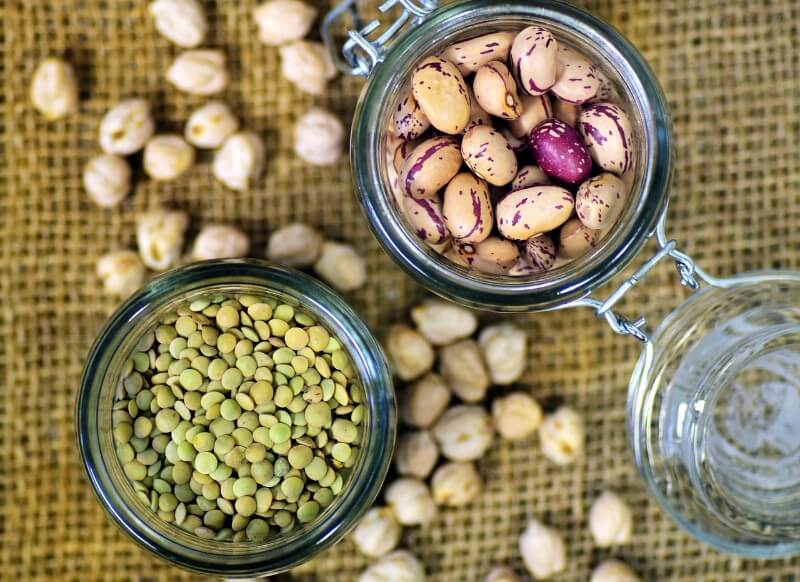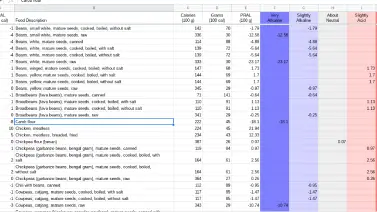
Acid-Alkaline Legumes and Legume Products Food Chart
Alkaline Legumes Update
I’m moving nutrient lists to ALKAscore. Where I’m also reconfiguring them to match the latest food groups. So it’s best to search for your favorite alkaline legumes. Or start from the new Food Groups Index. But note that legume’s replacement group is called Peas, Beans, and Lentils. However, this only includes pulses from leguminous plants. For example, only dried peas are included. While fresh peas are in the other vegetables group. Reflecting the nutrient contents of fresh legumes versus pulses.
Furthermore, the Pea Beans Lentils group is unusual. Because the group can be treated as a protein group in vegetarian dietary patterns. Otherwise, it is treated as a vegetable group. Accordingly, you will use either (DGA Food Group 1: Vegetable Peas, Beans, Lentils) or (DGA Food Group 5: Protein Peas, Beans, Lentils). Note that these are the same foods. But they are managed differently within plant-based or mixed dietary patterns.
Here at Foodary, I’ll continue to investigate how diseases and wellbeing are affected by poultry. Both as a group, and for individual poultry products.
Individual Legumes Science
Where I find studies about the effects of poultry on health and wellbeing, I will summarize them. Including articles on the effects of black beans, chickpeas, garbanzo beans, hummus, kidney beans, lentils, lima beans, pigeon peas, soybeans, and tofu. So please let me know if you have special interest in any of these foods. Because that helps me prioritize my research.
Alkaline Legumes List
I’ve retired the old format for Alkaline Legumes List. But the original list is available as a free Alkaline Legumes Spreadsheet. Or, you will find it in the free resources listed in your dashboard if you subscribe to my free Foodary Nexus Newsletter…
Subscribe to Free Foodary Nexus
Subscription is free, and your email address is safe - I will never share it with anyone else. I use Gumroad to provide this service, as described at the Foodary Nexus Newsletter Service.
I’ve added extra columns to the spreadsheet to help you make choices about legumes consumption. In particular, you can now compare PRAL values per 100 calories. So here are two examples from opposite ends of the range…
Highest Acid Load Legumes Products
I’ve listed these acid-forming legumes with the highest acid load first. Where the first number in the list is PRAL value per 100 calorie serving:
- 19 ┈ Soy protein isolate
- 14 ┈ Soy protein concentrate, crude protein basis (N x 6.25), produced by acid wash
- 12 ┈ MORI-NU, Tofu, silken, lite extra firm
- 11 ┈ Soy protein isolate, potassium type, crude protein basis
- 10 ┈ Luncheon slices, meatless
- 10 ┈ Chicken, meatless
- 9 ┈ Soyburger
- 9 ┈ Meatballs, meatless
- 9 ┈ Vegetarian meatloaf or patties
- 8 ┈ Vegetarian stew
Lowest Acid Load Legumes Products
Here, I’ve listed alkaline legumes with the lowest acid load. But you must remember that we never aim to eliminate acid-forming foods. Because we need to balance some acidic foods with more alkaline foods. So that daily PRAL totals become negative.
Therefore, choosing legumes with the lowest acid load makes it easier to achieve your daily PRAL target. So, this list continues with the format of starting with PRAL value per 100 calorie serving:
- -12 ┈ Beans, liquid from stewed kidney beans
- -11 ┈ Bean beverage
- -11 ┈ Tofu, salted and fermented (fuyu), prepared with calcium sulfate
- -8 ┈ Carob flour
- -7 ┈ Soy flour, full-fat, raw
- -7 ┈ Beans, white, mature seeds, raw
- -5 ┈ Lima beans, large, mature seeds, raw
- -5 ┈ Soy meal, defatted, raw
- -4 ┈ Beans, white, mature seeds, canned
- -4 ┈ Beans, french, mature seeds, raw
- -4 ┈ Beans, black, mature seeds, raw
- -4 ┈ Lima beans, large, mature seeds, cooked, boiled, with salt
- -3 ┈ Beans, pink, mature seeds, raw
- -3 ┈ Beans, kidney, california red, mature seeds, raw
- -3 ┈ Pigeon peas (red gram), mature seeds, raw
Remember: these tables help you make better food choices, but the only way to confirm they are having the desired effect is by measuring the pH (acidity/alkalinity) of your urine. This is a simple process using widely available pH test strips or meters.

Your Acid-Alkaline Legumes
Do you need more information about Acid-Alkaline Legumes? Perhaps you need to know, “Are baked beans acidic?” Or, “Are chickpeas alkaline?”
Whatever your question, ask about acid-alkaline legumes in the feedback form below.
I’m working on templates that help you identify, understand, and resolve your alkaline legumes concerns. In the meantime, you can start by adding notes about what you’ve learned about alkaline legumes so far.
All you do is highlight any text that interests you. Then click “Annotations” to personalize any Foodary page. Which means you can keep your alkaline legumes notes linked here, where you can always find them.
Do you need help with annotations? Or other unanswered questions or unresolved concerns? Then please tell me below. Or, if you prefer to use email, then subscribe to my free newsletter.
Leave Acid-Alkaline Legumes to browse other food group tables page.
Alkaline Legumes Comments
I’ve moved commenting into the Foodary Nexus. Where you can share your questions, experiences, and opinions about alkaline legumes. For more information, I recommend that you subscribe to my free newsletter.
If you are asking a question, it is best to:
- Search for that question in the Foodary Search Engine first.
- Choose the most relevant result.
- Refer to that result as you ask your question.
Acid-Alkaline Legumes Related Topics
Please remember: to find more related pages that are relevant to you, use the search box near the top of every page.
Common Terms: Most Helpful Foodary Articles, peanut, protein, reflux, seeds, tomato
Other posts that include these terms:
- Alkaline Grains List
- Alkaline Herbs and Spices
- Acid-Alkaline Dairy and Egg Products Food List
- Alkaline Drinks List
- Acid-Alkaline Beef List
- Alkaline Nuts and Seeds List
- Alkaline Fish List
- Alkaline Fruit Juice and Fruits List
- Acid-Alkaline Poultry Products Food List
- Alkaline Meats List
- Acid-Alkaline Vegetables Food List
- Acid-Alkaline Soups, Sauces, and Gravies Food List

